Andy Lloyd's Dark Star Blog

Blog 87 (January-February 2022)
The Dark Star's L1 Lagrangian Point
Around the time I wrote 'Dark Star' (1), I proposed a radical hypothesis to explain Nibiru's retrograde incursion through the solar system. I had already realised that a sub-brown dwarf companion would have to be too far away at perihelion to pass among the planets. I speculated that as this companion object approached its closest point (still well beyond the Kuiper Belt) an object that was in turn orbiting it might make its way among our planetary system.
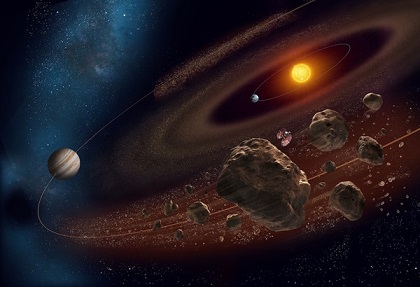
Image Credit: Roen Kelly
This 'ferry' would be Nibiru, perhaps taking the form of a small moon (2). The idea was a big hit on the Internet among Planet X enthusiasts. I remember Lloyd Pye emailing me to ask why I hadn't told him about it before it went viral. The idea is still a part of Planet X lore (see the item above (3)).
The scenario I proposed is contingent upon whether a loosely bound moon could be pulled away from the sub-brown dwarf by external gravitational forces. If the binary companion is located remotely, and is therefore not directly affect by the gravitational influence of Neptune, then it seems reasonable to suppose that it might have orbiting moons at an extended distance from itself. An issue arises should the Dark Star system make an approach to the edge of the solar system proper (e.g. approaching the outer planets). Each planet has a sphere of influence over its moons that is dependent upon its mass. This is known as the Hill Sphere.
Earth's Hill sphere extends out to about 1.5 million kilometres, or 0.01 AU. The radius of Jupiter's Hill Sphere, by comparison, is about 10 times greater, or about 0.1 AU (4). This will be similar in magnitude to a binary companion's own sphere of influence over its moons. This is considerably less than the distances I have described in this article. That's not to say that an object cannot orbit outside that limit; but that the further away it is, the more likely it will be affected by other influences which will degrade the planet's hold on that moon.
Essentially, if my 2004 hypothesis was correct, then a loosely bound 'ferry' object accompanying the Dark Star system could be subject to forces during perihelion which would likely break its connection with its parent system. (My argument also sought to provide an explanation for the meaning of the name 'Nibiru' - the 'ferry').
There are other potential solutions to this problem. For instance, a 'ferry' might be located within the L1 'Lagrangian' point of the Dark Star's extensive eccentric orbit, where gravitational and centrifugal forces are finely balanced.
Each planet has five LaGrange points, the stability of which vary with location. L4 and L5 are relatively stable, running along the orbital path of the planet itself. In Jupiter's case, these areas are home to the Greeks and Trojans respectively. If objects accompanying the Dark Star were located at L4 or L5 then they would share the planet's orbital path (either as heralds or followers).
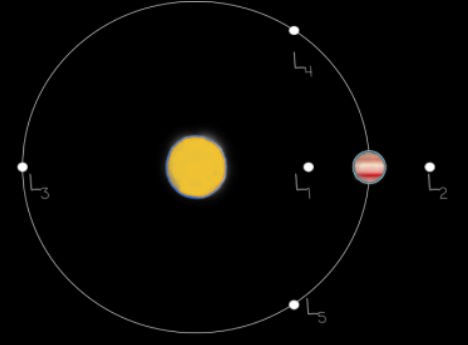
Let's consider Jupiter's less celebrated L1 position:
"L1 is between the Sun and Jupiter, where their gravities both balance perfectly! Interestingly, L1 has a smaller orbit path than Jupiter’s, but an object in L1 has the same orbital period as Jupiter." (5)
L1 is about 0.3 AU away from Jupiter. Given that the Dark Star's own orbit is absolutely massive, the distance between this its L1 point and the binary companion would be very considerable - perhaps of the order of 30 AU for a Planet X object located 500 AU away. The Dark Star's L1 position could therefore be located ~30AU closer to the Sun, along the Dark Star/Sun axis. A loosely bound object located here might pass considerably closer to the planetary zone of the solar system than the Dark Star itself as both swing around the Sun, and thus offer a staging post for travel between the two systems:
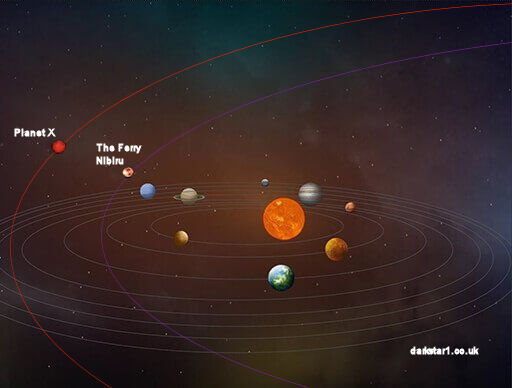
There is one other thing to bear in mind. A retrograde objects is affected far less than a prograde object. In a theoretical study on how densely packed a planetary system could become whilst retaining internal stability, astrophysicist Sean Raymond noted that planets orbiting in opposing directions have far less influence over each other that those circling in the same direction (6). This is because oppositely-orbiting objects experience comparatively fleeting encounters:
""If two planets in different orbits are going in the same direction, then they have a longer time to encounter each other as they pass, which creates a larger gravitational kick," Raymond said. "However, if they are going in the opposite direction, they zoom past each other and interact for a shorter amount of time," which means they can be closer together without colliding or scattering." (6)
Hence, Nibiru's allegedly retrograde motion brings with it distinct advantages: It is far less likely to be adversely affected by the other planets during any perihelion passage.
Written by Andy Lloyd, 18th January 2022
References:
1) Andy Lloyd "Dark Star: The Planet X Evidence" Timeless Voyager Press, 2005
2) Andy Lloyd "Nibiru: The Solution" 18 January 2005
3) Andy Lloyd "Brown Dwarf - Come Out, Come Out.... Wherever You Are" 29th January 2022
4) 'Hill sphere'
5) "How do Lagrange Points Work?" 4 September 2021
6) Harry Baker "What's the maximum number of planets that could orbit the sun?" 12 February 2022, with thanks to Sean Raymond
The Early Earth's Water
There's a new hypothesis doing the rounds to explain how the Earth got its oceans. This has been a big question for a long time among scientists, with a marked split between geophysicists and astronomers on the origin of our water. How to square the circle of a molten Earth losing its volatile materials during waves of catastrophic bombardment (including by 'Theia', the planet whose collision with proto-Earth led to the formation of the Moon) and the obvious anomalous evidence of our oceans. The Earth is relatively close to the Sun compared to most of the planets in the solar system, and was therefore subject to much more heat. This should have stripped off a lot of its volatile elements and compounds early on, including its nascent water.

Geophysicists have often argued that the water was initially trapped underground, making its way to the surface later once things had cooled down a bit. Water is easily mixed within magma, for instance (1). Astronomers offer a different perspective, pointing to the collision of those very celestial bodies as sources of cosmic water from the heavens. Perhaps there's some truth in both theories. However, complicating matters is the difference between the isotopic fingerprint of the waters on Earth compared with those analysed on comets. Earth's waters most closely resemble water on asteroids in the outer asteroid belt, which is pretty weird when you think about it. Is it possible that the Earth and the asteroids share a common origin early on? The Dark Star blog has often argued that case (2).
The new Russian/Chinese hypothesis emerges from the geophysics camp. The argument being proffered is that water was trapped deep, deep down towards the centre of the Earth before the planet's iron core formed. So deep was this water that even a collision with another protoplanet was insufficient to shift it:
"In a recent study in Physical Review Letters, a Skoltech professor and his Chinese colleagues suggest a chemical compound that — although now extinct — could have preserved water deep underground in the violent era when massive collisions must have evaporated the Earth’s surface water. " (3)
The catch is that the water has to have been tied up in a material that could withstand extremely high temperatures and pressures. For this to work, the scientists involved have argued that the Earth once had a substantial amount of a hydrated chemical substance that is now extinct. Yep, you heard right. This stuff does not currently exist on Earth. But it might have once. There is just one "compound that fits the bill: magnesium hydrosilicate, with the formula Mg2SiO5H2, which is over 11% water by weight and is stable at pressures of more than 2 million atmospheres and at extremely high temperatures." (3)
This material can only remain stable under incredibly high pressures - way down in the planetary core. Because the Earth's core is now iron, it cannot exist in the planet's core now. But magnesium hydrosilicates might have before the iron sank down and coalesced into the current core, about 30 million years after the Earth first formed.
"In the first 30 million years of Earth’s history, before the Earth’s core was formed, these must have existed in the Earth, hosting much of Earth’s water." (4)
Of course, this is highly speculative. Proving such a contentious idea is quite impossible: Firstly, we can't directly determine what lies so deep within the Earth (or, indeed, within any other planet). Secondly, we can't determine whether this substance once existed naturally or not. There's no way of proving this beyond computer simulations. Despite these inherent (even pseudoscientific) issues, the hypothesis has been warmly received in the scientific literature, not least because if it was true it would solve a great many mysteries all in one fell swoop. For instance:
"The new hypothesis of water origin has implications for other celestial bodies, too. “Mars, for example, is too small to produce pressures necessary to stabilize magnesium hydrosilicate,” [Professor Artem] Oganov [of Skoltech] says. “This explains why it is so dry and means that whatever water exists on Mars, it likely came from comets.”" (3)
Essentially, the bigger the planet, the more water could have escaped escaping - if you see what I mean.
The Origin of Tiamat: The Water World
The obvious downside of this is explaining how so many asteroids in the inner solar system have such an abundance of water? (5) Why didn't they lose all their water early on? Unless they, too, originated from a substantial planet which had already cooled down before it was broken apart. In which case, the asteroid belt was once the scene of a massive celestial collision involving a massive watery planet. This is the idea offered by Zecharia Sitchin, based upon his controversial interpretation of ancient cosmology (7).

Many scientists think
that a planet could not have formed where the
asteroid belt is now, because of the relatively
close proximity to Jupiter. That's not to say that
the idea of a 'Planet V' in that zone has not been
seriously considered - even one that exploded (6)!
If exoplanet discovery tells us anything it's that
you should never say never. What is considered
impossible today is discovered tomorrow, and then
the theorists simply rebuild their simulations and
allow for what they previously discounted.
I've come across only one scientific paper that put
forward the idea that the Earth formed at the
asteroid belt and migrated inwards (I discuss this
further in 'Darker Stars' (9)). Perhaps Zecharia
Sitchin (7) has made this a no-go zone for
mainstream science, no matter how plausible it seems
to be.
I believe that the migration of Earth occurred during the period known as the 'Late, Heavy Bombardment' around 3.9 billion years ago. That mysterious bombardment occurred some time after the solar system had settled down into some semblance of order. I think that this series of cataclysmic events was initiated by the arrival of a substantial planet from interstellar space - the Dark Star. Some aspect of its entourage, perhaps a moon, ripped into the Earth at that time, propelling it inwards to its current position.
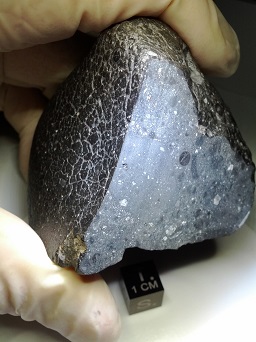
Image Credit: NASA (10)
It's now thought likely that the watery (and potentially habitable) phase on Mars took shape from this time forward. Recent geological evidence from the interior of a Martian meteorite has forced scientists to reconsider the red planet's own watery past (9).
“Prior studies of zircon in Martian meteorites proposed that conditions suitable for life may have existed by 4.2 billion years ago based on the absence of definitive shock damage” Dr [Aaron] Cavosie [from Curtin University’s Space Science and Technology Centre] said.
"“Mars remained subject to impact bombardment after this time, on the scale known to cause mass extinctions on Earth. The zircon we describe [found in Martian meteorite NWA 7034,colloquially known as ‘Black Beauty’ (10)] provides evidence of such impacts, and highlights the possibility that the habitability window may have occurred later than previously thought, perhaps coinciding with evidence for liquid water on Mars by 3.9 to 3.7 billion years ago.” (11)
This Martian connection adds fuel to the fire of this argument. Let's say Earth's watery precursor 'Tiamat' was struck by a moon-sized object about 3.9 billion years ago, spilling water out into space. Let's say that Tiamat was located near the asteroid belt. We not only explain Earth's watery past, but also the emergence of an asteroid belt full of water with the same isotopic signature as Earth's oceans. Further, some of that colossal spillage of water will have found its way to Mars triggering its own water phase after 3.9 billion years.
But we're still left with the question: Where did all that water come from in the first place? How is it possible there was so much water swilling around in the inner solar system? French scientists have recently proposed that a huge amount of water in the early inner solar system was originally sourced from interstellar space. They have been studying "the isotopic composition of hydrogen in calcium–aluminium-rich inclusions (CAIs) from primitive meteorites, the oldest Solar System rocks, to establish the hydrogen isotopic composition of water at the onset of Solar System formation" (12). The evidence led them to the conclusion that " the isotopic composition of inner Solar System water was established during the collapse of the protosolar cloud core owing to a massive admixture of interstellar water." (12)
This is incredibly welcome news for anyone interested in Zecharia Sitchin's cosmology. If true, it verifies that the water present on Earth is much the same as that present during the planet-building phase of the early solar system. The Earth's water was part of a massive reservoir of water available within the inner solar system, sourced from an interstellar gas cloud which merged with the Sun's protoplanetary disk.
"Their data show that two gas reservoirs existed
during the first 200,000 years of our solar system,
even before the formation of the earliest planetary
embryos. One of these reservoirs consisted of the
solar gas in which all the matter of our solar
system originated. With the meteorite, the
scientists were able to measure its record directly
for the first time ever. The second gas reservoir
was enriched in water vapour and already had the
isotopic signature of terrestrial water. It was
created by a massive influx of interstellar water in
the hot internal regions of the solar system, upon
the collapse of the interstellar envelope and the
formation of the protoplanetary disc. The early
existence of this gas with Earth-like isotopic
composition implies that Earth’s water was there
before the accretion of the first constituent blocks
of our planet." (13)
Therefore, there was PLENTY of water available to
create the watery monster Tiamat. The Earth didn't
receive its water from comets. Quite the contrary.
The massive bombardments it suffered later only
served to deplete its stock of water over time,
exacerbated by the action of the solar wind
stripping away much of its supply of volatile
materials. The early Earth was a much larger water
world, embedded within a wet inner solar system.
Written by Andy Lloyd, 26th January 2022, and updated 3rd February 2022
References:
1) Caroline Dorn and Tim Lichtenberg "Hidden Water in Magma Ocean Exoplanets" The Astrophysical Journal Letters, 922(1):L4 16 November 2021
2) Andy Lloyd "Earth's Primordial Waters" 24 November 2015
andylloyd.org/darkstarblog32.htm
3) Skoltech "Researchers Probe Earth’s Turbulent Past To Explain Where Oceans Came From" 25 January 2022
4) Han-Fei Li, Artem Oganov et al. "Ultrahigh-Pressure Magnesium Hydrosilicates as Reservoirs of Water in Early Earth" Phys. Rev. Lett. 128, 035703, 21 January 2022
5) Meghan Bartels "How Much Water May Be Tucked Away in Nearby Asteroids?" 11 March 2019
6) Tom Van Flandern "The challenge of the exploded planet hypothesis" International Journal of Astrobiology, 6(3): pp. 185 - 197, July 2007
cambridge.org/core/journals_article
8) Zecharia Sitchin "The Twelfth Planet" Avon Books 1976
7) Andy Lloyd "Darker Stars" Timeless Voyager Press 2019
9) Morgan Cox, Aaron Cavosie et al. ‘Impact and habitability scenarios for early Mars revisited based on a 4.45-Ga shocked zircon in regolith breccia’ Science Advances, 8(5) 2 February 2022
10) NASA ""Black Beauty" Mars Meteorite" 25 January 2019
11) Lucien Wilkinson "Shocked zircon find a ‘one-off gift’ from Mars" Curtin University Press Release, 3 February 2022
12) J. Aléon, D. Lévy, et al. "Determination of the initial hydrogen isotopic composition of the solar system", Nature Astronomy, 3 February 2022
13) The CNRS "Earth’s water was around before Earth" 3 February 2022
Voyage to Sedna, Anyone?
It wasn't so long ago that the New Horizons probe triumphantly visited not just distant Pluto, but also the Kuiper Belt Object 2014 MU69, aka Ultime Thule, aka 486958 Arrokoth, aka Snowman (1). This lay another billion miles distant, and was the furthest object ever visited by a space probe. In April 2021, New Horizons was 50 Astronomical Units away from Earth. The Pioneer and Voyager probes are all more than 100AU away now, the furthest being Voyager 1 reaching 152AU in April 2021 (2).
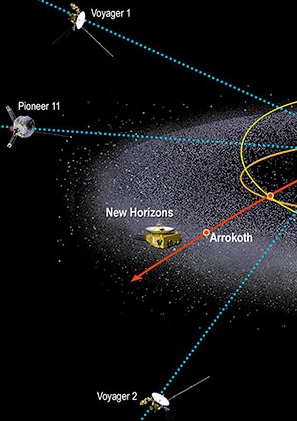
Image Credit: (NASA/JHUAPL/SwRI)
It takes decades to cover these kinds of distances. Planning a mission to objects way beyond Neptune is a logistical nightmare, requiring careful appraisal of the positions of the planets along the way (for the much-needed gravity assists) and a mission team in place that can last the test of time. Then there's the on-board power source issue - solar panels won't do so far away from the Sun, so the probes needs to be nuclear-powered. There is also significant red-tape to navigate: in particular, the 1992 Principles relevant to the Use of Nuclear Power Sources in Outer Space in international law (3), although it would be relatively easy to argue that a spacecraft sent to the outer solar system would count as an exception to this rule. The New Horizons probe is nuclear-powered, for instance, so a precedent has been set.
The potential rewards of such a mission are also significant. Humanity extends its understanding of the outer solar system and the objects which inhabit these outer realms. On a geopolitical level, only NASA has managed to go beyond Neptune - an achievement it has accomplished five times now. The Russians never secured the technological capability to compete with the remarkable Voyager and Pioneer programs. The Chinese are set to try their hand with two Interstellar Heliosphere probes (IHP-1 and IHP-2), both ear-marked for launch in 2024 (4). This may well renew interest among the Americans and Europeans to explore the planets and other objects in the vast reaches of the outer solar system.
Some of these objects behave very oddly. Their orbits and their alignments in space provide controversial evidence for another sizeable planet out there somewhere, invisibly pulling their strings. Trying to locate this Planet X object has been an ongoing controversy for years but if its existence could be proven it would be a delicious target for a future space mission. How feasible it would be, given the distances involved, is another matter.
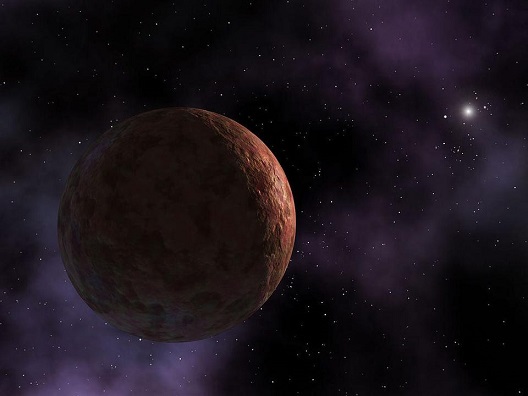
Image Credit: NASA/JPL-CALTECH/R. HURT (SSC-CALTECH)
90377 Sedna is a mysterious object in the outer solar system with a phenomenally eccentric orbit. It was discovered in 2003 - a feat possible only because it is gradually approaching its perihelion (at 76 AU) scheduled for 2076 (5). Its 11,400 year orbit takes it out as far as ~940 AU. It might be a scattered disk object which originated near to the Kuiper Belt or, alternatively, its origin might be the inner Oort Cloud beyond its current orbit (6). Because its origins (and those of the other so-called Sednoids) is mysterious, the perihelion passage of Sedna provides an opportunity to study a true enigma - one which may unlock the key to Planet X.
Getting out that far will take a spacecraft about 25 years. Astrophysicist Ethan Siegel has argued that we need to get our skates on if we're going to grab this opportunity:
"... we can send a mission to the outer Solar System to reach [Sedna] as it nears its perihelion. But due to the orbital particulars of all the planets in our Solar System, we really only get two chances. They're both coming up fast: 2033 and 2046, if we want to truly learn about this fascinating relic from our Solar System's formation." (6)
An alternative launch date has recently been proposed by a team of scientists led by Vladislav Zubko from the Space Research Institute of the Russian Academy of Sciences, based upon a series of possible trajectories to Sedna (7). The team argues for a launch date of 2029, although 2034 is still on the table (8). The argument goes that a slower journey there means a longer rendezvous when the spacecraft eventually encounters Sedna. That factor favours a 30-year journey over, say, an express 20-year voyage. More reason for mission planners to be given an early green light.
Written by Andy Lloyd, 10th January 2022
References:
1) NASA "New Horizons Spacecraft Returns Its Sharpest Views of Ultima Thule" 22 February 2019
2) "NASA's New Horizons reaches rare distance, looks out to Voyager" 15 April 2021
3) Mathilde Minet "The Use of Nuclear Powered Engines in Outer Space" 18 December 2020
4) List of Solar System probes
5) Andy Lloyd "Sedna: A Clue to Nibiru" 15 March 2004
6) Ethan Siegel "Is Humanity Ignoring Our First Chance For A Mission To An Oort Cloud Object?" 22 May 2018
7) Scott Alan Johnston "2029 Will be the Perfect Year to Launch a Mission to Sedna" 1 January 2022
8) Vladislav Zubko et al "Analysis of Mission Opportunities to Sedna in 2029-2034" Advances in Space Research 68(7): 2752-2775, 1 October 2021
Brown Dwarf - Come Out, Come Out.... Wherever You Are
An incoming brown dwarf and its contingent of 7 planet/moons is once again being rolled out as the bringer of imminent apocalypse. This time around (and how many times have we been through this already??) the rumour mill has been stoked up by English researcher Mark Elkin. He writes extensively about an imminent and highly destructive pole shift event. In 2019, he tied this in with the magnetic field of the alleged in-coming brown dwarf object (1). This material has been posted on Facebook and is currently doing the rounds in social media (2) - perhaps spurred on by the movie 'Don't Look Up' (2). I've tried to add a counterpoint to Elikin's Facebook page but my post was immediately deleted.
It's not clear where Elkin has got his actual data from about the alleged position of this brown dwarf object. Now that it's 2022, one would presume that he thinks the brown dwarf system is practically on top of us. He makes some quite extraordinary claims about that will happen and how on Earth it has evaded detection by, well, just about everyone else:
"So the brown dwarf could
still be 25 million miles away from earth when this
occurs but nibiru/Planet X will pass between the
distance of earth and the moon as it orbits the
brown dwarf (nemesis).
Will we see the planet crossing?
YES. And it will cover most of the sky from your
perspective but you’ll get little warning from your
government. Less time= less panic.
Can we see the brown dwarf?
Rarely. Not only is the brown dwarf only visible in
the infrared spectrum, it’s also well hidden by NASA
(sun simulation unit being one)." (1)
Clearly, my own research publications about the passage of the Dark Star have played a central role in the mechanics described in Elkin's posts (4). Elkin doesn't reference anyone's work in his posts (Basic Research 101). Despite clearly grounding his ideas about the brown dwarf binary companion on my own Dark Star Theory, his wanton speculation has taken things off in a ridiculous direction. Make of it what you will in these post-Truth times. All I know is this - if an actual brown dwarf was bearing down on the inner solar system, it would already be a bright night-time object: A red planetary disc of a similar magnitude to Jupiter. We'd all know about it because we'd all be able to see it.
Just look up. It's not there.
Written by Andy Lloyd, 29th January 2022
References:
1) Mark Elkin "POLE SHIFT- past, present, future. Part 1" 4 March 2019
2) Mark Elkin "POLE SHIFT- past, present, future. Part 1" 10 May 2019, with thanks to Simon
3) 'Don't Look Up', 2021
4) Andy Lloyd "Nibiru: The Solution" 18 January 2005
Wide Binary Brown Dwarfs
Astronomers have identified a pair of rare 'blue' L-dwarfs that are orbiting each other at a great distance (optically, they're actually red in colour but are on the cool end of the infrared spectrum - thus denoted as 'blue'). These two tiny brown dwarfs are about 130 Astronomical Units apart, which is about four times the distance to Neptune (1)!
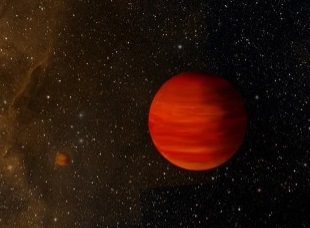
Image credit: William Pendrill
If such a binary companion was located in our own solar system, then it would definitely be a Planet X-type object - albeit one weighing in at about 65 Jupiter masses. But this binary pairing, known as CWISE J0146−0508AB, doesn't even have a proper star to hold them together. This remarkable couple have retained their incredibly wide orbit around each other despite each having a relatively miniscule gravitational field (at least in comparison to other types of dwarf star). Even though there have been about 50 brown dwarf binaries identified to date, none stretches the orbital range as much as this pair.
The discovery builds upon data from the space-based Wide-field Infrared Survey Explorer (WISE), gathered by the "BackYard Worlds (BYW): Planet 9" citizen science project. This popular project has been busily seeking evidence of brown dwarf in our neighbourhood for a few years now. The current paper extends that work by reviewing the BYW brown dwarf candidates using higher resolution surveys than WISE, like Pan-STARRS or the Dark Energy Survey. The images from these surveys were more likely to differentiate a binary system from an unresolved light source. And so it proved in the case of CWISE J0146−0508AB (2).
"The reddish color of each component in the Pan-STARRS1 and DES images
indicates very red optical colors, typical of cold brown dwarfs" (2)
In their paper, the team from UCSD have determined that these brown dwarfs are not young objects. This makes the degree of separation from each other all the more amazing. Why haven't they been pulled apart from one another by the galactic tide, or any other number of external forces (like passing stars). That's an open question by now, but analysis of the the light emanating from each brown dwarf indicates a "conservative age range of 0.5–10 Gyr for this pair".
"...we determined component spectral types of L4 and L8 (blue), making CWISE J0146−0508AB one of only a few benchmark systems with a blue L dwarf. CWISE J0146−0508AB has a projected separation of ~129 au, making it the widest-separation brown dwarf pair found to date.
"...Such a wide separation for a brown dwarf binary may imply formation in a low-density star-forming region".
(2)In other words, there can't have been many other stars around early in their lifetimes, otherwise they would have been dragged away from one another early on. This finding indicates the potential longevity of very wide binary objects in loosely bound orbits. Extrapolated up to a star like the Sun and one can quite imagine a Nemesis-like object holding on throughout the lifetime of the solar system.
Written by Andy Lloyd, 20th February 2022
References:
1) Keck Observatory "Astronomers Discover Widest Separation Of Brown Dwarf Pair To Date" 17 February 2022
2) Emma Softich et al. "CWISE J014611.20–050850.0AB: The Widest Known Brown Dwarf Binary in the Field", The Astrophysical Journal Letters, 926(2): L12
Ancient 'Bioengineering' Confirmed
Really? Could those far-out ideas about genetic engineering in ancient Mesopotamia have a true basis in fact? Has modern science confirmed that speculative reasoning of the controversial author Zecharia Sitchin is for real? If you take the following LiveScience headline at face value, you could be forgiven for thinking so:
"1st bioengineered hybrid animals discovered — in ancient Mesopotamia". (1)
In fact, the story relates to the selective breeding of domesticated donkey and wild ass hybrids. The ancient and now extinct animals were known as 'Kungas', and were used ~2500BCE by the Sumerians to pull their war chariots. This was at least 500 years before horses were brought down from the Caucasian steppe to accomplish the same task.

Image credit: Thierry Grange/IJM/CNRS-Université de Paris
It's no surprise that Sumerians were ahead of the game with selective breeding of animals. They were ahead of their time in everything. If he was alive today, Sitchin would likely argue that the Sumerians learned these technologies, which arose incredibly rapidly during their watch, from others - i.e. the Anunnaki (2). Given that such feats included the hybridisation of hominids with the ancient alien colonists, we can imagine that allying donkeys and asses would have been pretty run-of-the-mill stuff.

Image credit: Glenn Schwartz/Johns Hopkins University
These extinct equine hybrids were a bit of a mystery because one of their proposed precursors, the Syrian wild ass, was too small to fit the kunga bill. Not so, it has now been realised: Ancient wild asses were bigger, apparently (3). (That's one for TikTok!) And very wild indeed - not an easy task to entice them into doing the necessary with a donkey.
"Because each kunga was sterile, like many hybrid animals such as mules, they had to be produced by mating a female domesticated donkey with a male wild ass, which had to be captured... That was an especially difficult task because wild asses could run faster than donkeys and even kungas, and were impossible to tame...
""They really bio-engineered these hybrids," [study co-author Eva-Maria] Geigl [a genomicist at the Institut Jacques Monod in Paris] told Live Science. "There were the earliest hybrids ever, as far as we know, and they had to do that each time for each kunga that was produced — so this explains why they were so valuable."" (1)
Which I guess proves that Enki must have been pretty handy with a lasso.
Written by Andy Lloyd, 28th January 2022
References:
1) Tom Metcalfe "1st bioengineered hybrid animals discovered — in ancient Mesopotamia" 14 January 2022, with thanks to Lee
2) Zecharia Sitchin "The Twelfth Planet" Avon Books 1976
3) E. Andrew Bennett et al. "The genetic identity of the earliest human-made hybrid animals, the kungas of Syro-Mesopotamia" Science Advances, 8(2) 14 January 2022
Gloster Ghosts Revamp
About 15 years ago, the Cosnette brothers and I had a great time investigating paranormal phenomena. We had a couple of websites going devoted to our ghosthunts. It was so popular that we received anomalous photos from readers all over the world. We even took part in a pilot TV episode. I've had a lot of fun recently revamping the Gloster Ghosts section of the Dark Star website:
As part of that work, I finally I got around to publishing something about the Ghosthunter TV pilot we made in 2010. We filmed two amazing ghost-hunts, culminating in some remarkable footage. The following report includes links to a couple of YouTube videos where you can see us in action:
Ghoster Ghosts - Our TV Pilot Footage
Written by Andy Lloyd, 9th February 2022



